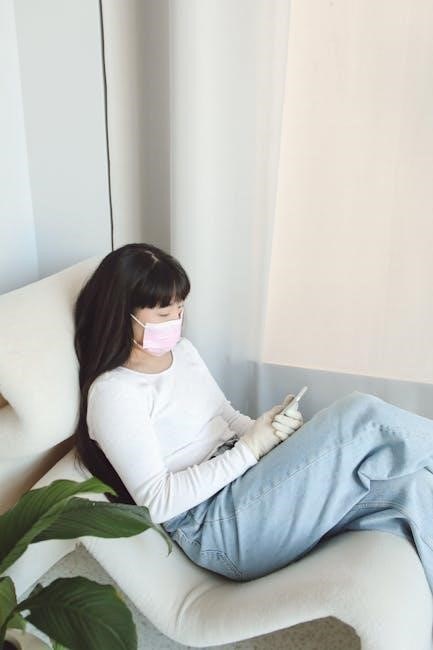OptiBond Solo Plus is a single-component, total-etch dental adhesive designed for direct and indirect bonding applications․ It offers high bond strength, durability, and protection against microleakage, making it a versatile solution for various clinical needs․
1․1 Overview of OptiBond Solo Plus
OptiBond Solo Plus is a single-component, total-etch dental adhesive designed for use in various clinical applications․ It is specifically formulated to provide high bond strength and long-term durability․ The adhesive is filled with 0․4 micron barium glass fillers, which enhance its performance and ensure sustained bonding to enamel, dentin, and other surfaces․ Its unique composition makes it suitable for direct and indirect bonding procedures, offering convenience and efficiency in dental practices․ OptiBond Solo Plus is known for its ability to protect against microleakage, ensuring reliable and durable restorations․ Its user-friendly design eliminates the need for multiple components, simplifying the application process for dentists․ This makes it a popular choice for a wide range of dental bonding needs․
1․2 Key Features and Benefits
OptiBond Solo Plus offers several key features that make it a highly effective dental adhesive; Its single-component formula simplifies application, eliminating the need for multiple steps or mixing․ The adhesive is designed for total-etch techniques, ensuring a strong bond to enamel and dentin․ It contains 0․4 micron barium glass fillers, which enhance its durability and bonding performance․ OptiBond Solo Plus provides excellent protection against microleakage, promoting long-term restoration success․ Its versatility allows for use in direct and indirect bonding applications, including composite restorations, amalgam sealing, and post-and-core procedures․ The product is user-friendly, saving time and reducing the risk of errors․ These features make it a reliable choice for achieving consistent, high-quality results in dental bonding procedures․
Instructions for Use
Etch enamel and dentin with 37․5% phosphoric acid for 15 seconds, rinse thoroughly, and gently dry․ Apply OptiBond Solo Plus for 15 seconds, air thin, and light cure for 10 seconds․

2․1 Step-by-Step Application Guide
Etch enamel and dentin with 37․5% phosphoric acid for 15 seconds․
Rinse thoroughly for 15 seconds to remove all etchant․
Gently air dry without desiccate․
Apply OptiBond Solo Plus to the prepared surface for 15 seconds using light brushing․
Air thin for 3 seconds to avoid pooling․
Light cure for 10 seconds․
This ensures proper bonding and prevents microleakage, providing a durable and long-lasting result․
2;2 Pre-Etching Procedure
The pre-etching procedure is essential for ensuring proper surface preparation․ Begin by applying 37․5% phosphoric acid etchant to both enamel and dentin using a light brushing motion․ Allow the etchant to act for 15 seconds to demineralize the enamel and open the dentinal tubules․ After etching, rinse the surface thoroughly with water for 15 seconds to remove all residual etchant․ Gently air dry the area with a clean, oil-free air stream, taking care not to desiccate the tooth structure․ This step ensures a clean, receptive surface for the application of OptiBond Solo Plus, promoting optimal bonding performance and durability․
2․3 Application of OptiBond Solo Plus
Apply OptiBond Solo Plus to the prepared enamel and dentin surfaces using a light brushing motion․ Ensure a thin, even layer is achieved to cover the entire surface․ Allow the adhesive to act for 15 seconds to penetrate and bond with the tooth structure․ Avoid pooling or over-application, as this can compromise the bonding process; Use a clean, dry applicator or brush to remove any excess material․ OptiBond Solo Plus is specifically formulated to create a strong, durable bond between the tooth and restorative material, ensuring long-term clinical success․ Proper application is critical for achieving optimal results․
2․4 Air Thinning and Light Curing
After applying OptiBond Solo Plus, air thin the adhesive for 3 seconds to remove excess material without desiccating the surface․ This step ensures an even layer and prevents pooling․ Next, light cure the adhesive for 10 seconds using a dental curing light․ The light curing process initiates polymerization, creating a strong and durable bond․ Avoid over-curing, as this may compromise the material’s properties․ Proper air thinning and light curing are critical to achieving optimal bond strength and ensuring the longevity of the restoration․ Follow the manufacturer’s guidelines for light intensity and duration to guarantee the best results․

Specialized Applications
OptiBond Solo Plus is ideal for direct composite bonding, indirect techniques, amalgam sealing, and porcelain/metal applications, ensuring versatility in specialized dental procedures․
3․1 Direct Composite Bonding
OptiBond Solo Plus excels in direct composite bonding, providing a strong and durable bond between composite materials and tooth structures․ Its total-etch formula ensures effective enamel and dentin bonding․ The adhesive is applied after etching and rinsing, followed by air thinning to prevent pooling․ Light curing for 10 seconds finalizes the bond․ This process enhances the composite’s integration with the tooth, minimizing microleakage and ensuring long-term clinical success․ The single-component design simplifies the procedure, making it efficient for dentists․ OptiBond Solo Plus is ideal for anterior and posterior restorations, offering reliability and consistency in direct composite bonding applications․
3․2 Indirect Bonding Techniques
OptiBond Solo Plus is highly effective in indirect bonding techniques, ensuring a reliable bond between composite materials and various substrates․ Its single-component formula simplifies the process, eliminating the need for additional primers or adhesives․ For indirect bonding, the adhesive is applied to the prepared surface in a thin, even layer, followed by air thinning to avoid pooling․ Light curing for 10 seconds finalizes the bond, creating a strong and durable interface․ This method is particularly useful for complex restorations, such as veneers or crowns, where precise bonding is critical․ OptiBond Solo Plus’s compatibility with various materials, including metal and zirconia, makes it a versatile choice for indirect bonding applications, ensuring long-term clinical success and patient satisfaction․
3․3 Amalgam Sealing Process
OptiBond Solo Plus is effective for amalgam sealing, a process that ensures a tight seal between amalgam restorations and tooth structure․ Begin by preparing the amalgam surface using standard techniques, ensuring proper retention․ Etch the enamel and dentin for 15 seconds with a 37․5% phosphoric acid gel, then rinse thoroughly and air dry․ Apply OptiBond Solo Plus to the prepared surface using a light brushing motion for 15 seconds․ Air thin for 3 seconds to avoid pooling and light cure for 10 seconds․ This process enhances the bond between the amalgam and tooth, reducing microleakage and improving restoration longevity․ OptiBond Solo Plus’s adhesive properties ensure a durable seal, making it ideal for amalgam sealing procedures․
3․4 Porcelain and Metal Bonding
OptiBond Solo Plus is ideal for bonding to porcelain and metal surfaces, ensuring a strong and durable connection․ For porcelain bonding, apply a silane primer to the etched surface and dry lightly․ Then, apply OptiBond Solo Plus to all surfaces and air thin for 3 seconds to prevent pooling․ Light cure for 10 seconds․ For metal bonding, ensure the surface is clean and etched․ Apply OptiBond Solo Plus evenly, air thin, and light cure․ This process enhances adhesion, reducing microleakage and improving restoration longevity․ OptiBond Solo Plus’s filler content and adhesive properties make it suitable for both porcelain and metal, providing a reliable bond in various clinical scenarios․

Indications for Use
OptiBond Solo Plus is indicated for direct composite restorations, composite to composite bonding, post and core applications, amalgam sealing, and bonding to porcelain and metal surfaces․
4․1 Direct Composite Restorations
OptiBond Solo Plus is ideal for direct composite restorations, ensuring a strong bond between composite materials and tooth structures․ Its total-etch formula simplifies the process, requiring enamel and dentin etching for 15 seconds with 37․5% phosphoric acid․ After rinsing and lightly drying, the adhesive is applied in a thin layer using a light brushing motion․ Air thinning for 3 seconds prevents pooling, followed by a 10-second light cure․ This procedure ensures optimal bonding, reducing microleakage and enhancing restoration durability․ The adhesive’s filler content reinforces the hybrid layer, providing long-lasting results․ Clinicians appreciate its ease of use and compatibility with various composites, making it a reliable choice for everyday restorative procedures․
4․2 Composite to Composite Bonding

OptiBond Solo Plus is highly effective for bonding composite to composite, ensuring a strong and durable connection․ Its single-component formula simplifies the process, eliminating the need for multiple steps․ After etching and drying the surface, the adhesive is applied thinly and evenly․ Air thinning for 3 seconds prevents pooling, followed by a 10-second light cure․ This technique minimizes microleakage and enhances the longevity of the bond․ The adhesive’s filler content reinforces the interface, providing exceptional strength․ Clinicians value its versatility and reliability in repairing or layering composites, making it an excellent choice for both anterior and posterior restorations․ OptiBond Solo Plus ensures a seamless bond, maintaining the integrity of the composite material․

4․3 Post and Core Applications
OptiBond Solo Plus excels in post and core applications, ensuring a robust bond between the post and tooth structure․ Begin by etching the canal with a 37․5% phosphoric acid gel for 15 seconds, then rinse and lightly dry․ Apply OptiBond Solo Plus in a thin, even layer to both the post and the prepared canal space using a light brushing motion․ Allow it to sit for 15 seconds, then air thin for 3 seconds to prevent pooling․ Light cure the adhesive for 10 seconds to activate its bonding properties․ This process enhances the bond strength and durability, crucial for withstanding occlusal forces․ OptiBond Solo Plus is compatible with various post materials, including metal and fiber, ensuring versatility in different clinical scenarios․ Its effectiveness in post and core applications is well-documented, providing long-term stability and reliability in restorations․
Chemical Composition
OptiBond Solo Plus contains 0․4 micron barium glass and silica fillers, enhancing bond strength and durability․ It is free from harmful substances like Bisphenol A (BPA), ensuring safety and reliability․

5․1 Filler Content and Role
OptiBond Solo Plus contains 0;4 micron barium glass and silica fillers․ These fillers reinforce the hybrid layer, improving bond strength and durability․ They also penetrate dentin tubules, enhancing adhesion to dentin surfaces and preventing microleakage․ The filler content ensures long-term stability of the bond, making it suitable for both direct and indirect restorations․ Additionally, the fillers contribute to the material’s resistance to wear and degradation, ensuring optimal performance in clinical applications․ The combination of these fillers is key to the product’s effectiveness in various dental procedures, providing a reliable and durable bonding solution․
5․2 Adhesive Properties
OptiBond Solo Plus exhibits excellent adhesive properties, ensuring strong and durable bonds to tooth structures․ Its single-component formula simplifies application, promoting optimal adhesion to enamel and dentin․ The adhesive creates a hybrid layer that integrates with the tooth structure, enhancing bond strength and reducing the risk of microleakage․ This makes it highly effective for both direct and indirect bonding applications․ The material’s formulation ensures reliable adhesion to a variety of surfaces, including composite, porcelain, and metal, making it versatile for clinical use․ Its adhesive properties are clinically proven to provide long-lasting results, contributing to the overall success of dental restorations․ This ensures both performance and patient satisfaction in various dental procedures․

Delivery Systems
OptiBond Solo Plus is packaged in a convenient, single-component system․ The dispenser ensures precise application, minimizing waste․ Tips include using the provided applicator for efficient bonding․
6․1 Packaging and Dispensing
OptiBond Solo Plus is supplied in a convenient, single-component packaging system designed for easy and efficient application․ The adhesive is dispensed through a precision applicator tip, ensuring accurate delivery to the desired surface․ This minimizes waste and allows for controlled placement, enhancing clinical efficiency․ The packaging is compact and lightweight, making it easy to handle and store․ The dispenser is ergonomically designed to reduce fatigue during use․ By using the provided applicator, clinicians can achieve consistent and precise application, which is critical for optimal bonding performance․ The system is also designed to maintain the integrity of the adhesive, preventing contamination and ensuring consistent quality․
6․2 Tips for Efficient Application
For efficient application of OptiBond Solo Plus, use a light brushing motion to apply the adhesive, ensuring even coverage․ Avoid pooling by air-thinning the material for 3 seconds before light curing․ Gently dry the surface beforehand to prevent excess moisture․ Use the provided applicator tip for precise placement, reducing waste․ Apply in thin layers to ensure proper penetration and bonding․ Avoid over-saturating the applicator, as this can lead to inconsistent application․ Keep the bottle tightly sealed when not in use to maintain product integrity․ Follow the recommended application time of 15 seconds for optimal results․ By adhering to these tips, clinicians can achieve consistent and reliable bonding outcomes with OptiBond Solo Plus․

Storage and Handling
Store OptiBond Solo Plus in a cool, dry place away from direct sunlight․ Keep the bottle tightly sealed when not in use to maintain product integrity and shelf life․
7․1 Shelf Life and Storage Conditions
OptiBond Solo Plus has a shelf life of 24 months from the date of manufacture when stored under proper conditions․ It should be kept in a cool, dry place, away from direct sunlight and moisture․ The ideal storage temperature ranges between 15°C and 25°C (59°F to 77°F)․ Avoid freezing, as it may alter the product’s consistency․ The adhesive should be stored in its original container, tightly sealed, and in an upright position to prevent leakage․ Once opened, use the product within 6 months for optimal performance․ Always check the expiration date on the label before use․ Proper storage ensures the adhesive’s effectiveness and longevity, maintaining its bonding properties for reliable clinical outcomes․
7․2 Safety Precautions
OptiBond Solo Plus should be handled with care to avoid skin and eye contact, as it may cause irritation․ Wear protective gloves, safety glasses, and work in a well-ventilated area to minimize exposure․ In case of skin contact, wash thoroughly with soap and water․ For eye exposure, flush with water for at least 15 minutes and seek medical attention if irritation persists․ Avoid inhaling vapors or aerosols․ Dispose of unused product and packaging according to local regulations and environmental guidelines․ Keep out of reach of children․ In case of accidental ingestion, seek medical advice immediately․ Follow proper infection control procedures when handling dental materials․ Always refer to the Safety Data Sheet (SDS) for detailed information on handling and emergency procedures․
Troubleshooting Common Issues
Common issues include adhesive pooling and inadequate bond strength․ Ensure proper air thinning and avoid over-application․ Verify etching and drying steps for optimal results․
8․1 Avoiding Pooling of Adhesive
Avoiding pooling of OptiBond Solo Plus is crucial for ensuring a strong, even bond․ After applying the adhesive, use a gentle air stream to thin it uniformly across the surface․ This step helps prevent excess material from accumulating in low areas․ Proper air thinning for 3 seconds is recommended to achieve an optimal bond․ Additionally, using a light brushing motion during application can help distribute the adhesive evenly․ If pooling occurs, remove excess with a dry applicator or absorbent paper before light curing․ Proper technique ensures a thin, consistent layer, which is essential for maximizing bond strength and durability․
8․2 Ensuring Proper Bond Strength
Ensuring proper bond strength with OptiBond Solo Plus requires careful surface preparation and adherence to application guidelines․ Etch enamel and dentin with 37․5% phosphoric acid for 15 seconds, then rinse thoroughly to remove all residue․ Gently dry the surface without desiccating it․ Apply OptiBond Solo Plus in a thin, even layer using a light brushing motion for 15 seconds․ Air thin for 3 seconds to prevent pooling and ensure uniform coverage․ Light cure for 10 seconds to achieve optimal bonding․ Avoid contamination from saliva or blood during the process․ Proper technique and adherence to these steps are critical for achieving high bond strength and durability․ This ensures long-lasting clinical results, making OptiBond Solo Plus a reliable choice for dental applications․

Clinical Evidence and Performance
Clinical studies demonstrate OptiBond Solo Plus provides high bond strength to enamel and dentin, with excellent durability and protection against microleakage, ensuring reliable long-term clinical outcomes․
9․1 Bond Strength Data
OptiBond Solo Plus demonstrates impressive bond strength to both enamel and dentin, with clinical studies showing consistent and reliable results․ The adhesive achieves high initial bond strength, which remains stable over time, reducing the risk of degradation․ Its filler content, including 0․4 micron particles, enhances the hybrid layer and contributes to sustained bond durability․ Independent research highlights its superior performance compared to other adhesives, with minimal microleakage and excellent long-term clinical outcomes․ These properties make it a trusted choice for various dental procedures, ensuring durable and predictable results in both direct and indirect bonding applications․
9․2 Protection Against Microleakage
OptiBond Solo Plus is clinically proven to provide exceptional protection against microleakage, a critical factor in maintaining the integrity of dental restorations․ Its advanced formulation creates a robust hybrid layer, sealing the tooth surface effectively and preventing the penetration of bacteria, fluids, and ions․ Studies demonstrate that the adhesive’s high filler content and strong bond strength minimize marginal gaps, reducing the risk of microleakage․ This protection is particularly important for long-term restoration success, as microleakage can lead to secondary caries and restoration failure․ OptiBond Solo Plus’s ability to seal the interface between the tooth and restoration material ensures durable and predictable clinical outcomes․
Manufacturer’s Guidelines
Kerr Dental recommends following specific instructions for OptiBond Solo Plus, including etching times and application steps, to ensure compliance and optimal performance in clinical settings․
10․1 Kerr Dental Recommendations
Kerr Dental emphasizes adhering to specific guidelines for OptiBond Solo Plus to ensure optimal performance․ Etch enamel and dentin for 15 seconds with Kerr Gel Etchant, rinse thoroughly, and lightly dry․ Apply OptiBond Solo Plus for 15 seconds using a light brushing motion, ensuring even coverage․ Air thin for 3 seconds to prevent pooling and light cure for 10 seconds․ Avoid desiccating the tooth surface․ Kerr recommends following these steps precisely to achieve high bond strength and durability․ Always refer to the instructions manual for detailed procedures and safety precautions․ Proper usage ensures compliance with regulatory standards and delivers reliable clinical outcomes․
10․2 Compliance and Regulatory Information
OptiBond Solo Plus complies with international dental standards and regulatory requirements․ It is certified for safe use in dental procedures, adhering to FDA and CE marking guidelines․ The product is manufactured under strict quality control protocols to ensure reliability and consistency․ Kerr Dental provides detailed compliance documentation, including material safety data sheets and usage instructions․ Clinicians must follow all regulatory guidelines and safety precautions to maintain compliance․ Proper storage and handling, as outlined in the instructions, are crucial for maintaining product integrity․ Compliance ensures optimal performance and safety, aligning with global dental standards for adhesive systems;
OptiBond Solo Plus is a highly effective, single-component dental adhesive designed for both direct and indirect bonding applications․ Its compatibility with various surfaces, including enamel, dentin, composite, and metal, makes it a versatile choice for clinicians․ The product’s ability to provide sustained high bond strength and protection against microleakage ensures durable and reliable results․ With its user-friendly application process and adherence to regulatory standards, OptiBond Solo Plus stands out as a valuable tool in modern dental practices․ By following the provided instructions and guidelines, clinicians can achieve optimal outcomes, making it a preferred choice for a wide range of dental procedures․
